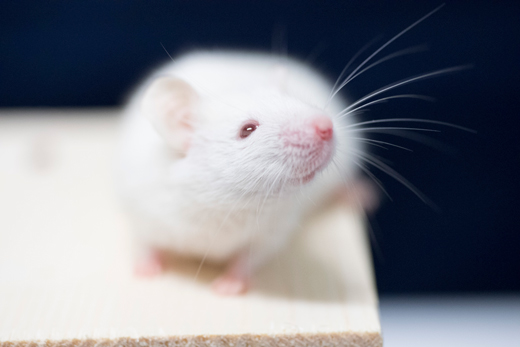NOG-ΔMHC
NOG-ΔMHC
Next Generation Severely Immunodeficient NOG-ΔMHC mouse

| Strain Name | NOG-Iab KO, B2m KO2 (NOG-ΔMHC) |
|---|
- You will be required to sign a consent form upon purchase.
- The use of this mouse strain corresponds to the use of Living Modified Organism (Cartagene Protocol, domestic law). We will send you an information provision form in advance, so please check it and use it according to the rules of each institution.
Development
It was established by mating NOG-B2m<em1Tac> mouse established by genome editing with NOG-H2-Ab1<tm1Doi> mouse.
Product Features
- It is MHC (Class I, Class II) deficient NOG mouse.
- Alleviation of Xenogenic Graft Versus Host Disease (GVHD) after hPBMC engraftment enabled long-term studies.
- In conventional NOG mouse, GVHD develops about 1 month after human PBMC engraftment, but it is possible to observe for a longer period of about 3 months.
Research Applications
- Studies such as efficacy evaluation of immune checkpoint inhibitors after cancer bearing using humanized NOG-ΔMHC mouse engrafted with human PBMC.
- Long-term experiments to evaluate the antitumor effects of CAR-T and TCR-T cells after transplant human cancer.
Background data
Video: NOG-ΔMHC and humanized NOG-ΔMHC
We will introduce the development history of NOG-ΔMHC mouse, the characteristics of humanized NOG-ΔMHC mouse engrafted with PBMCs, and their main research applications.
Humanized NOG-ΔMHC
- Human peripheral blood mononuclear cells (PBMC) engrafted humanized NOG-ΔMHC mouse is commonly used.
- We produce humanized NOG-ΔMHC mouse in Japan and deliver them to customers.
- Production will start after receiving your firm order.
- You will be required to sign a consent form upon purchase.
- The use of this mouse strain corresponds to the use of Living Modified Organism (Cartagene Protocol, domestic law). We will send you an information provision form in advance, so please check it and use it according to the rules of each institution.
Product features of humanized NOG-ΔMHC mouse engrafted with PBMCs
- It is MHC (Class I, Class II) deficient NOG mouse.
- Alleviation of Xenogenic Graft Versus Host Disease (GVHD) after hPBMC engraftment enabled long-term studies.
- In conventional NOG mouse, GVHD develops about 1 month after human PBMC engraftment, but it is possible to observe for a longer period of about 3 months.
- We are providing detailed briefings by online regarding the products features of humanized NOG-ΔMHC mouse, the production of humanized NOG-ΔMHC mouse, and experimental protocols for their use. Please feel free to contact us at Contact form.
Background data of NOG-ΔMHC mouse after PBMCs transferred
References
Therapeutic effects of anti-GM2 CAR T cells expressing IL 7 and CCL19 for GM2 positive solid cancer in xenograft model.(CAR-T cell; chemokine; cytokine; ganglioside; solid cancers; NOG ΔMHC mice)
Cancer Med. 2023 Jun;12(11):12569 12580. doi: 10.1002/cam4.5907. Epub 2023 Apr 9.
Takahiro Sasaki, Yukimi Sakoda, Keishi Adachi, Yoshihiro Tokunaga, Koji TamadaImproved anti-solid tumor response by humanized anti podoplanin chimeric antigen receptor transduced human cytotoxic T cells in an animal model.(CAR-T cells; chimeric antigen receptor; humanized antibody; podoplanin ; solid tumor; NOG ΔMHC mice)
Genes Cells. 2022 Sep;27(9):549 558. doi: 10.1111/gtc.12972. Epub 2022 Jul 17.
Akihiro Ishikawa, Masazumi Waseda , Tomoko Ishii, Mika K Kaneko, Yukinari Kato, Shin KanekoA T-cell-engaging B7-H4/CD3-bispecific Fab-scFv Antibody Targets Human Breast Cancer (ΔMHC, Breast cancer)
Clin Cancer Res. 2019 May 1;25(9):2925-2934. doi: 10.1158/1078-0432.CCR-17-3123. Epub 2019 Feb 8.
Akira Iizuka, Chizu Nonomura, Tadashi Ashizawa, Ryota Kondou, Keiichi Ohshima, Takashi Sugino, Koichi Mitsuya, Nakamasa Hayashi, Yoko Nakasu, Kouji Maruyama, Ken Yamaguchi, Yasuto AkiyamaHuman PBMC-transferred murine MHC class I/II-deficient NOG mice enable long-term evaluation of human immune responses.(PBMC-NOG-dKO, Cancer Immune therapy)
Cell Mol Immunol. 2018 Nov;15(11):953-962. doi: 10.1038/cmi.2017.106. Epub 2017 Nov 20
Tomonori Yaguchi, Asuka Kobayashi, Takashi Inozume, Kenji Morii, Haruna Nahgumo, Hiroshi Nishio, Takashi Iwata, Yuyo Ka, Ikumi Katano, Ryoji Ito, Mamoru Ito, Yutaka KawakamiAlloreactive T Cells Display a Distinct Chemokine Profile in Response to Conditioning in Xenogeneic GVHD Models.(NOG, NOG-ΔMHC, GVHD models)
Transplantation. 2019 Sep;103(9):1834-1843. doi:10.1097/TP.0000000000002756.
Kawasaki Y, Sato K, Nakano H, Hayakawa H, Izawa J, Takayama N, Mashima K, Oh I, Minakata D, Yamasaki R, Morita K, Ashizawa M, Yamamoto C, Hatano K, Fujiwara SI, Ohmine K, Muroi K, Ito R, Hayakawa M, Ohmori T, Kanda Y.Antitumor Effect of Programmed Death-1 (PD-1) Blockade in Humanized the NOG-MHC Double Knockout Mouse. (humanized mice, NOG-ΔMHC, Immune checkpoint inhibitor)
Clin Cancer Res. 2017 Jan 1;23(1):149-158. doi: 10.1158/1078-0432.CCR-16-0122. Epub 2016 Jul 25.
Ashizawa T, Iizuka A, Nonomura C, Kondou R, Maeda C, Miyata H, Sugino T, Mitsuya K, Hayashi N, Nakasu Y, Maruyama K, Yamaguchi K, Katano I, Ito M, Akiyama Y.The anti-tumor activity of the STAT3 inhibitor STX-0119 occurs via promotion of tumor-infiltrating lymphocyte accumulation in temozolomide-resistant glioblastoma cell line. (glioblastoma, NOG-ΔMHC)
Immunol Lett. 2017 Oct;190:20-25. doi: 10.1016/j.imlet.2017.07.005. Epub 2017 Jul 15.
Akiyama Y, Nonomura C, Ashizawa T, Iizuka A, Kondou R, Miyata H, Sugino T, Mitsuya K, Hayashi N, Nakasu Y, Asai A, Ito M, Kiyohara Y, Yamaguchi K.Improved engraftment of human peripheral blood mononuclear cells in NOG MHC double knockout mice generated using CRISPR/Cas9. (hu-PBMC engraftment, humanized NOG-ΔMHC mice)
Immunol Lett. 2021 Jan;229:55-61. doi: 10.1016/j.imlet.2020.11.011. Epub 2020 Nov 27.
Ka Y, Katano I, Nishinaka E, Welcker J, Mochizuki M, Kawai K, Goto M, Tomiyama K, Ogura T, Yamamoto T, Ito M, Ito R, Takahashi R.Antitumor activity of the PD-1/PD-L1 binding inhibitor BMS-202 in the humanized MHC-double knockout NOG mouse. (PBMC-NOG-dKO, Cancer Immune therapy)
Biomed Res. 2019;40(6):243-250. doi: 10.2220/biomedres.40.243.
Ashizawa T, Iizuka A, Tanaka E, Kondou R, Miyata H, Maeda C, Sugino T, Yamaguchi K, Ando T, Ishikawa Y, Ito M, Akiyama Y.Immunological responses against hepatitis B virus in human peripheral blood mononuclear cell-engrafted mice. (HBV, PBMC-humanized mice, NOG-ΔMHC)
Biochem Biophys Res Commun. 2018 Sep 10;503(3):1457-1464. doi: 10.1016/j.bbrc.2018.07.063. Epub 2018 Jul 20.
Aono S, Tatsumi T, Yoshioka T, Tawara S, Nishio A, Onishi Y, Fukutomi K, Nakabori T, Kodama T, Shigekawa M, Hikita H, Sakamori R, Takahashi T, Suemizu H, Takehara T.

